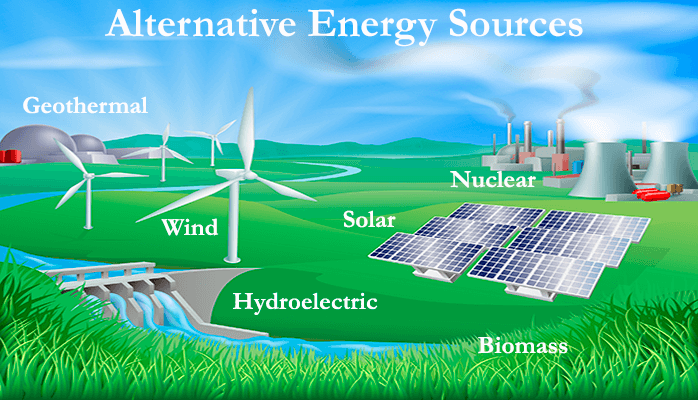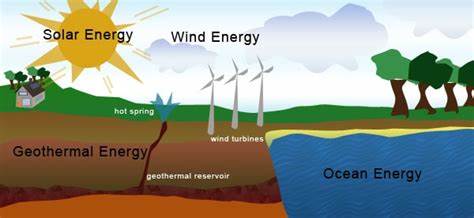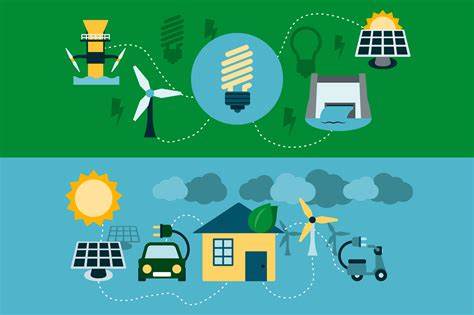Advantages and Disadvantages of Energy ResourcesIn contrast to non-renewable resources, which eventually run out, renewable resources are always available. A forest and a coal mine make an easy comparison. While the forest may get exhausted, if managed, it can serve as a constant source of energy instead of a coal mine that has been used up and is no longer there. Renewable energy sources make up the majority of the earth's energy supply. Renewable energy sources provide more than 93 percent of the country's total energy reserves. To compare renewable resources with non-renewable resources, renewable resources were multiplied annually by thirty years. In other words, if all renewable resources were used, and non-renewable resources were uniformly exhausted in 30 years, non-renewable resources would only make up 7% of the resources available each year. 
A renewable energy source is any limitless energy source found in nature. For instance, renewable energy sources include the sun, wind, water power, and the earth's internal heat. These energy sources can be found in nature, where they are also continually replenished. This prevents them from ever becoming worn out or running out. Renewable resources have far outpaced energy output. As people grow more educated about the drawbacks of fossil fuels, they are more inclined to choose renewable energy sources. Renewable energy is created when it is produced using renewable energy sources. Any energy source that replenishes spontaneously over a brief time, typically less than a year is referred to as a renewable energy source. Our contemporary society is advancing the use of numerous clean, renewable energy sources. Solar, wind, geothermal, hydropower, and biomass energy are a few sources. 
The Primary Categories of Renewable Energy Sources are:
The energy that comes from the sun is referred to as solar energy. Solar cells are the objects used to store solar energy. Solar panels are exposed to the sun's rays, which are subsequently captured by solar cells and stored. Heat and light are produced from solar energy. The solar energy that strikes the solar panels is converted to thermal energy, which is then used for various heating applications.
Wind energy is produced using the wind's force. Several windmills are placed to capture the energy of the wind and then produce electricity.
To harness the power of the wind, wind turbines are used. These turbines can supply energy to buildings, towns, and even entire villages. Since wind energy is a completely renewable resource, it is a great solution for people wishing to lessen their dependency on fossil fuels.
Electricity is produced by harnessing the power of moving water. One of its advantages is the efficiency of hydroelectric power, which can turn up to 90% of the energy from moving water into electricity. The power of rivers and streams can be captured by hydroelectric dams and used to power buildings such as residences, businesses, and other structures.
The heat that is stored on the earth is used to produce this energy. This energy can be used to generate electricity or heat a home.
Tidal energy produces electricity by utilizing the rise and fall of the tides. Turbines are used in tidal power plants to harness the energy of moving water and use it to produce electricity. Although this form of renewable energy is still being developed, it has a lot of potential because of how frequently the oceans move.
Utilizing organic materials like wood to create electricity is known as biomass energy. These substances are burned in biomass power plants to create steam, which powers a turbine to generate electricity. Because it is an excellent way to use organic waste materials, this type of renewable energy is frequently used in rural areas. 
Advantages of Energy Resources
The globe would remain completely dark without electricity. All people's lives now depend heavily on electricity. People continuously rely on electricity to complete business and domestic tasks, from industries to domestic purposes. Electricity is needed to run appliances like air conditioners, pumps, and refrigerators. Solar panels, nuclear power plants, dams, and wind turbines are a few ways electricity is produced.
One of the main benefits of energy sources is their ease of transportation. If there was no diesel or gasoline, no car could operate. Therefore, these two energy sources were in use before discovering alternate energy sources. Following extensive processing and refinement, gasoline and diesel are separated from petroleum. Today, it would not be easy to envision a world where transportation consisted of carts. A month's travel can now be completed in a matter of minutes because of the energy sources on the globe.
The global economy has benefited greatly from the energy sector. The supply and demand for energy on a global scale, together with the financial performance of energy producers, are major factors. Energy-related businesses like mining, oil and gas drilling, refining and pipelining, and pipeline construction have significantly contributed to modernity and globalization.
Millions of people have found work due to industrialization driven by the production of oil and gas, hydroelectric power plants, and nuclear power plants. As we get more advanced, there will be more jobs in the energy business. According to the Environmental Energy Study Institute, the number of people engaged in the renewable energy sector in 2018 increased by 700,000 to 11 million. The job patterns also indicate a gradual uptick in current figures compared to prior years. Thus, one of the energy sources' largest benefits will be new work opportunities.
Most renewable energy sources, including wind, solar, tidal, nuclear, water, and wave energy, are eco-friendly and don't hurt the environment. Such energy sources won't impact people or the local wildlife because they don't release harmful greenhouse gases or toxins into the environment. Disadvantages of Energy Resources
The cleanest energy source is hydrogen, but storing and moving around can be challenging. Given that it requires specialized facilities and is lighter than gas, many difficulties must be overcome. Furthermore, industrial areas may experience serious risks due to hydrogen leaks.
There is evidence that the carbon dioxide emissions from gasoline, diesel, fossil fuels, coal, and biomass are higher. These energy sources are the main contributors to greenhouse gas emissions that weaken the ozone layer and contribute to global warming. Even if there is a viable substitute for these fuels, humanity will take a long time to completely and permanently move to a cheap energy source.
The facilities for fuel extraction have consistently been in the spotlight for manufactured disasters, from Deepwater Horizon to the Chornobyl accident. Dams, nuclear power plants, and gas stations are dangerous to residential and commercial areas. The worth and fertility of the land in the surrounding areas are diminished by such incidents, which also interfere with wildlife. Remember that catastrophic disasters have the potential to obliterate an entire population.
A lot of money is spent on everything, from planning to construction. One of the major drawbacks of energy sources is that costs are frequently difficult to incur. For instance, it costs more money and takes longer to set up oil drilling facilities and nuclear power plants. Furthermore, putting in large-scale solar cell installations requires space and money, which might be spent only once.
Some energy sources aren't constantly accessible; for instance, solar cell panels won't work while it's raining or storming. Like sea tides can only produce tidal energy, windmills can only be used in windy conditions.
Renewable energy must be made widely accessible, which will require significant investments. Another drawback to bringing solar, wind, and large-scale wind farms online is the distribution network. However, these technologies sound fantastic.
However, carbon emissions are a reality. Renewable energy technology manufacturing accounts for all the carbon footprint associated with green energy. At the same time, the issue of how to recycle solar panels and wind turbines remains unresolved. But when more green energy is sent to the grid, we'll use it to develop renewable energy sources. The result is analogous to exponential growth: the more renewable energy sources you have, the less carbon is produced during the production of new solar and wind energy systems.
The production of green energy can be impacted by geographic considerations as well. No matter how efficient they are, solar panels in Alaska can never match those in Nevada or Colorado. However, geothermal energy is far more prevalent in Alaska than on the east coast, and biomass made of organic materials is commonly utilized to heat homes and greenhouses.
When the sun does not shine as brightly, early in the morning and late at night are the times when most energy is used. Energy generation and needs are only sometimes fully matched with renewable energy. Although renewable technologies and energy storage are still very expensive, their costs decrease yearly thanks to investments in these fields.
Solar and wind farms require much more space than conventional fossil fuel-based plants to produce the same amount of green energy. However, investments in the renewable industry are essential given the urgent need for efficiency improvements and the ambitious carbon reduction targets; non-renewable sources are expected to achieve higher efficiency levels. The ConclusionThe usage of various forms of energy has advantages and disadvantages. The usage of fossil fuels, coal, and gasoline is also related to additional drawbacks. There is only one benefit to them: they are inexpensive.
Next TopicAdvantages and Disadvantages of Gadgets
|
 For Videos Join Our Youtube Channel: Join Now
For Videos Join Our Youtube Channel: Join Now
Feedback
- Send your Feedback to [email protected]
Help Others, Please Share










